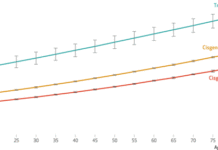
Recently enacted and proposed legislation threatens the fundamental rights of members of sexual and gender minority (SGM) groups in the United States. Many of these policies harm health and limit access to health care. For example, Texas Governor Greg Abbott issued a directive to investigate parents for child abuse when they seek gender-affirming care for their children, and Florida prohibited discussions about sexual orientation and gender identity (SOGI) in classrooms under legislation that opponents call the “Don’t Say Gay” bill. Other bills that would criminalize the delivery of gender-affirming care have been introduced,1 despite opposition from major national medical organizations and substantial evidence that such care significantly reduces suicidality and poor mental health outcomes among transgender adolescents.1,2
As policymakers continue to target SGM people, the health care sector can play a critical role in mitigating resulting harm and advocating for evidence-based policies protecting health and well-being. We believe the Triple Aim framework — which consists of enhancing patients’ care experiences, improving population health, and reducing per-capita costs of care — can help identify existing challenges and next steps for promoting SGM health.
SGM people often have negative health care experiences. For example, transgender patients are frequently targets of discrimination during health care encounters; a 2015 national survey found that 23% of transgender adults avoided necessary health care because of fear of mistreatment by providers.2 Rates were especially high among transgender adults who were also members of marginalized racial or ethnic groups, which demonstrates the intersectional burdens of transphobia and racism. Among lesbian women, fear of discrimination drives lower rates of Pap testing than those among heterosexual women, despite their additional risk factors for cervical cancer.2
As compared with the general population, SGM people have higher rates of cardiovascular disease, obesity, cancer, and sexually transmitted infections, including HIV, human papillomavirus, syphilis, and hepatitis C.2 They also have substantially higher rates of certain mental health problems, including depression, anxiety, and substance use disorders, and are more likely to attempt suicide. Poor physical and mental health is linked to factors such as minority stress (stress associated with belonging to a marginalized group), discriminatory policies, and barriers to care.
There is not enough information to compare health care expenditures between SGM and non-SGM people, primarily because SOGI data are not routinely collected or included in commercial and public claims data sets. A 2021 Department of Health and Human Services (HHS) report found that SGM people are more likely than non-SGM people to delay care because of cost and to worry about paying medical bills. In addition, 18% of SGM people (vs. 4% of non-SGM people) delayed counseling or therapy because of cost, despite SGM populations having worse mental health and a higher trauma burden. Certain health care services used primarily by SGM people may also be prohibitively expensive or inadequately covered by insurance. According to the Movement Advancement Project, as of April 2022, Medicaid programs in only 24 states and Washington, D.C., explicitly covered gender-affirming care for transgender people. Some progress has been made on expanding insurance coverage among SGM people, primarily under the Affordable Care Act and through enhanced opportunities for spousal employer-sponsored insurance related to marriage equality.
Moving forward, several steps could support data collection, financing models, workforce development, and social protections to improve health among SGM people. These steps offer an opportunity for the health care sector to align with and build upon the executive order that President Biden recently signed, on June 15, 2022, to advance equality for SGM people.
First, the health care sector could collect additional standardized SOGI data to inform tailored quality-improvement, research, and policy initiatives. Most current SGM health data were collected from national surveys, rather than electronic health records (EHRs) or claims databases. Starting in 2016, the Health Resources and Services Administration (HRSA) required federally qualified health centers to report patient SOGI data that are collected using approved questions. Health centers were provided free, customized training to support adoption. Between 2016 and 2019, the percentage of such facilities collecting SOGI data for at least 75% of patients increased from 14.9 to 53.0%.3
The Centers for Medicare and Medicaid Services could consider similar requirements and training as part of federal payment and quality-reporting programs (e.g., the Merit-Based Incentive Payment System for providers and Medicare Part C reporting requirements for Medicare Advantage plans). Since 2018, HHS has required all EHR systems certified under the meaningful-use incentive program to be capable of collecting SOGI data, but it does not require health care organizations to systematically collect these data. Additional SOGI data-collection incentives and requirements from Medicaid state agencies, state health exchanges, and commercial insurers could advance alignment among payers. Future efforts could support the adoption of standardized SOGI data elements in EHRs, in line with updated 2021 HHS interoperability standards.
Second, collection of more complete data could drive payment reform to advance the Triple Aim. Health systems and payers could stratify measures related to health outcomes, utilization, and patient experience according to SOGI to generate quality-improvement reports. Payers could then link payment to equity measures under emerging value-based payment models, for instance by awarding bonuses for reporting on and reducing SGM health disparities. Comprehensive data could also inform government safety-net and public health programs. HRSA has funded federally qualified health centers that have historically been focused on SGM communities, such as Fenway Health in Boston (where one of us works), and has supported the Ryan White HIV/AIDS Program to improve access to and quality of care for people with HIV, which disproportionately affects SGM people.2 HHS could use comprehensive patient data to prioritize filling care gaps and addressing unmet needs among SGM people living in underserved and underresourced communities.
Third, workforce development is needed to ensure that health professionals can support the specific needs of SGM people. A 2009–2010 survey of U.S. and Canadian medical schools found that students received a median of 5 hours of SGM-related medical education and that 33% of schools provided no SGM-related clinical training.4 There are still no explicit requirements from the Liaison Committee on Medical Education or the Accreditation Council for Graduate Medical Education for including SGM-specific health care topics in curricula. A recent study of residents in 120 U.S. internal-medicine programs revealed mean scores of 50 to 52% on a baseline assessment evaluating foundational knowledge of SGM health.5
Medical schools and residency programs could establish competencies and introduce SGM health curricula that are developed, reviewed, and delivered by SGM health experts. Faculty can leverage training resources curated by organizations focused on SGM health, such as the National LGBTQIA+ Health Education Center at the Fenway Institute. Integrated content and practical experiences could be woven throughout core curricula to expand training that has historically been limited to electives and extracurricular initiatives.
Finally, physicians and their professional organizations can advocate against harmful legislation and for protective policies addressing the upstream political and social determinants of SGM health. Despite recent progress, explicit and broad protections based on SOGI are not common features of federal laws; instead, protections depend heavily on heterogeneous state- and municipal-level policies. Twenty-two states still permit conversion therapy for SGM adolescents, and only 23 states and Washington, D.C., have prohibited anti-SGM bullying in schools, despite the connection of conversion therapy and bullying with psychological distress and suicidality.1,2
Policies affirming fundamental rights have been shown to ease minority stress among SGM people. For example, quasi-experimental analyses found that the implementation of marriage equality significantly reduced suicidality among SGM adolescents and mental health visits among SGM adults.2 Federal legislation is needed to provide broad and clear protections for these populations; one such bill is the Equality Act, which would amend the 1964 Civil Rights Act to explicitly prohibit SOGI-based discrimination. Researchers can continue to investigate the health consequences of anti-SGM legislation and the potential benefits of protective policies and interventions.
As policymakers endanger health and access to care among SGM communities, we believe the health care sector should rededicate itself to supporting health equity for these populations. The Triple Aim offers providers, payers, researchers, and policymakers a common set of goals for protecting the health of SGM populations. The health care sector can commit to equitable resource allocation, care experiences, and health outcomes for people of all sexual orientations and gender identities.








